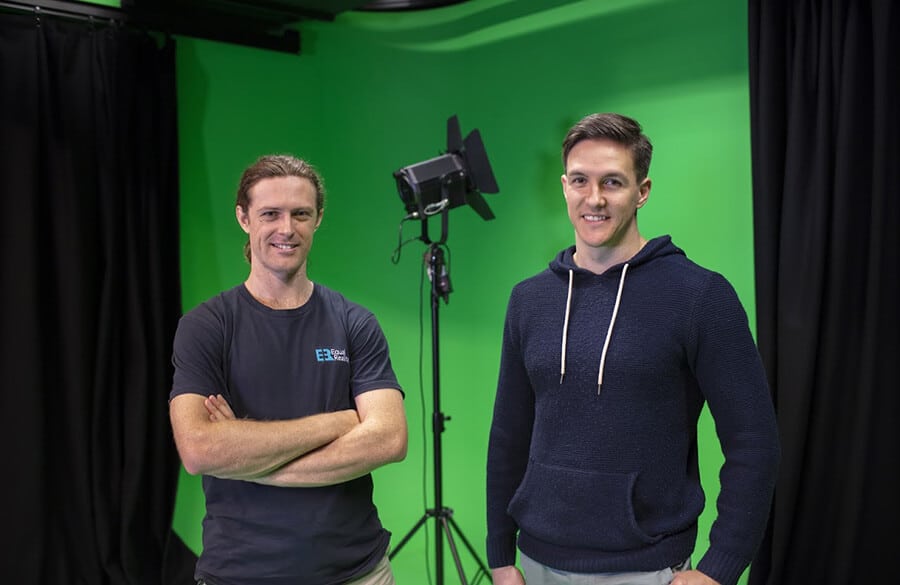Brennan and Rick's first project was a VR training application around gender and disability. Today, more than 45 world-leading companies work with Equal Reality while their trainings are used in every single continent on the planet except Antarctica. Two wildly different masterminds have managed to developed a strong partnership with one key goal – to enrich the world we live in with kindness and compassion, celebrating diversity.
Meet Brennan and Rick. The first one dropped out of college to create science fiction technology like holograms. Before crossing ways with Rick he was busy building hi-tech in Silicon Valley. Rick, on the other hand, an entrepreneur in the fields of tech and law, was testing his adrenalin limits by working in enterprise tech sales and stockbroking! Everything changed when they met by chance in a local mall in their home town four years ago. Their ideas, experience, and brilliance interlaced into a mutual vision – to start developing inclusive technology.
Dear Rick and Brennan, thank you so much for taking the time to share your journey with us! You two have met in very unusual circumstances, four years ago. Tell us more about it and who came up with the idea of making an Equal Reality?
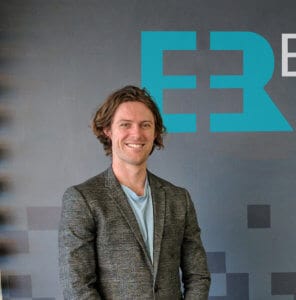
Brennan: As a young kid I was an avid gamer and I taught myself to program computer games at the age of 14. At 20, I was headhunted, dropping out of my computer science degree to create augmented reality glasses that projected holographic models into the real world. I was employee #7 at a tech startup Meta. I joined Meta to experience building high tech in Silicon Valley and go through the world’s most prestigious entrepreneur program YCombinator, to learn about scaling a company. While at Meta we raised $72M, where I was the glue between their hardware, software, and developer community. Knowledge sharing and community as always been important to me. At Meta, I was responsible for passing on the knowledge of leaders experts in the AR VR space to our developer community, and the needs of the developer community to the team at Meta. This gave me incredible insights into the technology, the industry, how it was used and its strengths.
I left Meta after 3 years to apply my learning of VR & Startups in the space of EduTech. On this journey, I met Rick Martin.
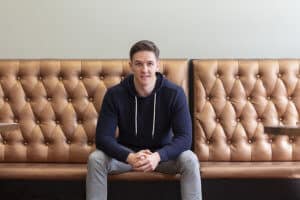
Rick: I was a Law and Commerce graduate student having stints working in investment banking an in-law. After university, I worked in enterprise tech sales and finance across the globe for companies like Bloomberg and IBM. I saw how technology could be leveraged to share knowledge, information, and solve problems. It was while I was studying Disciplined Entrepreneurship with MIT when me and Brennan started working together on finding a way to use Virtual Reality for inclusion.
Despite both being born in Wollongong and students of the University of Wollongong, our meeting was by chance at the local mall several years after university. I was in Wollongong visiting family, and Brennan was running a public mixed reality event. We soon discovered that our skills and personalities were wildly different but complementary. We are particularly ethically and vision aligned, we work well together and have the same vision of the future we wish to create.
Rick, your career path before the Equal Reality could be described as an earth-shaking and exciting roller coaster! What was a trigger for you to switch from the hustle of Wall Street, where you worked as a broker, into the Virtual Reality world?
I believe this line of work chose me, I didn’t choose it.
I have valued the various diverse experiences that I have been fortunate to have been exposed to and it allowed me to find new passions, interests, and see the world in a different way. I had a particular passion and interest in technology, people and cultural diversity. As with most things, it is not where you are but who you are with. Crossing paths with Brennan was a catalyst that has redirected my career. We have very similar visions and ethics and our diverse skills, experiences and personalities have allowed for a great partnership to develop.
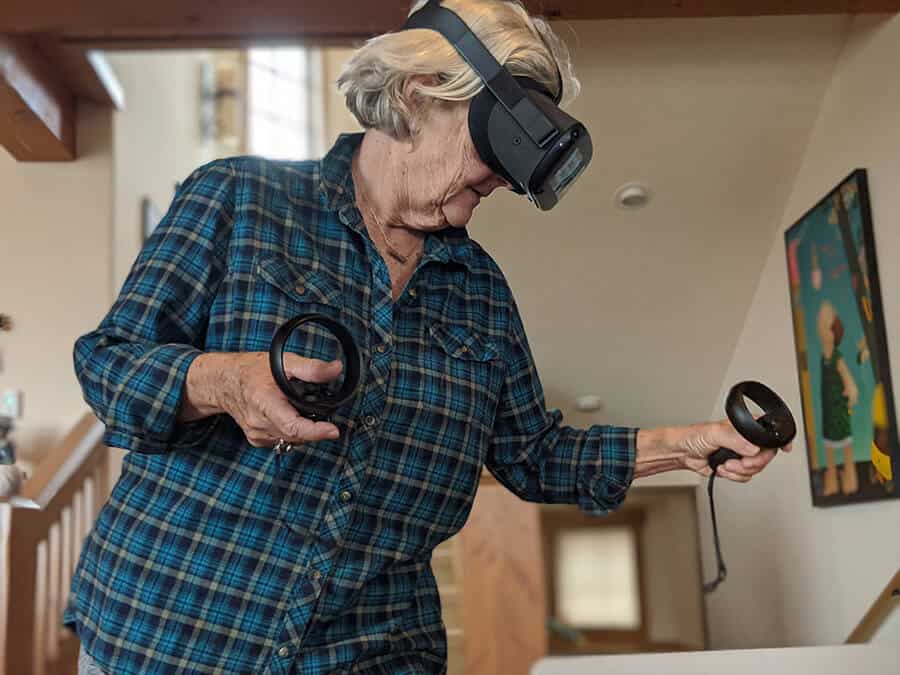
Funnily enough, we met in the local mall at our home town. He had created a mixed reality VR game that was like a lightbulb moment for me. We started to work together with this technology in education in November 2016, and both knew that this technology had the potential to give users experiences that they could never have had in real life. We both wanted to see a world where there was more empathy for other perspectives for more inclusion, this was the change we wanted to drive, and no one else was doing it. And today, we believe it is more important than ever before.
You were named on the elite Forbes 30 Under 30 list of the world’s most innovative entrepreneurs. How much has this recognition helped you in going forward with your plans and new business adventures?
Being named Forbes 30 Under 30 has helped us a lot, particularly as Australians in the US market.
We were really proud of making the list and receiving recognition for the work we were doing and had done. It has really helped us to catapult into the US market, which is where the majority of our work is currently focused.
Rick, MIT’s Global Entrepreneurship Bootcamp was an unbeatable experience and of the most intense ones you have had, when it comes to your professional challenges. Share with us some interesting details about it and tell us more about the impact it had on what you and Brennan are doing today?
I think the framework of MIT’s Global Entrepreneurship Bootcamp is an incredible tool for any entrepreneur to follow. If I were to summarize it, it is a framework to allow entrepreneurs to focus on uncovering authentic problems and maximizing their focus through disciplined practice. Much of the entrepreneurship experience can be exceptionally wild and distracting, but toolsets to follow such as this can really help drive the competitive advantage of a team to define and solve problems in an effective way. One of the principles that stand out for me is that the startup “idea” is not the most important element of the business. This is overrated and what is actually important is the team and the team’s ability to execute is more important than any “idea” in itself.
Training for scientists for research in Antarctica, art projects, games, famous Coachella Festival…these are just some of the things you worked on applying VR technology and its benefits. Which project do you both remember as the most demanding one, so far?
Recently we have built a project for Cornell University using VR for Gender and Racial discrimination. This project has been the most demanding for a few reasons.
The project is led by a team of diversity and inclusion experts at Cornell University. From the beginning, we knew it was going to be our most important project yet and we needed to stretch ourselves to be more innovative than ever before. We completely reinvented our technology to reach new heights of achievement.
An important aspect of all of our projects is collaboration and partnerships with experts and people who experience discrimination. During the Cornell project, we wanted to build a virtual reality system for those with and without sight. We were privileged to work closely with Angela Winfield, who is the Associate Vice President for Inclusion and Workforce Diversity, and someone with first-hand experience of living legally blind since the age of 10. She was instrumental in creating our first virtual reality for people who are blind or vision-impaired by using voice recognition technology and 3D spatial sound to allow for complete experience reflecting sounds in the real world. Additionally, the virtual reality has been designed for people who are hearing impaired or deaf by using subtitles and high-quality visuals.
We are really proud of this application that has reached an unprecedented level of quality that we hope will help even more people to engage with and benefit from the capabilities of virtual reality.
What are the key benefits of VR practices compared to traditional teaching methods?
Traditional methods for teaching soft skills topics, like unconscious bias are quite limited. They usually are classroom-style workshops, or tick-box style e-learning. When we think about perspective-taking and empathy, we need to give people an experience, but using traditional methods like in-person role-playing isn’t scalable.
If you want to reach a large audience, you can use e-learning. However, it is often more of a ‘tick and flick’ course with limited real impact. When virtual reality is used for educational purposes the student is not simply watching the lesson but becomes a part of the lesson and experience. The learning retention rate for traditional methods is approximately 5%, for virtual reality this increases to 75%, meaning students are significantly more likely to recall and implement their learnings.
Virtual Reality is a safe space and allows participants to understand their own biases and prejudices without the fear of being judged for making mistakes that they can then learn from.
Virtual Reality allows for a much larger audience to have access to empathy experiences. If more people in an organization are able to have access to this training it can be used to drive significant change for the organization’s culture. Virtual Reality is a safe space and allows participants to understand their own biases and prejudices without the fear of being judged for making mistakes that they can then learn from.
Users as experts of their own VR experience
Among several services your company offers, you do scaling based on training customized for a company or school. How does one training look like and how do you measure results or effectiveness of it, afterward?
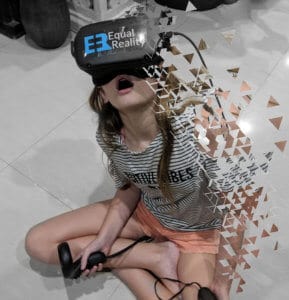
Depending on what results the organization is looking for the training can be run in different ways, from workshops to, a VR kiosk, run remotely and even at home.
What does not change is how the VR experiences are designed to lead to empathy, awareness and behavior change.
Every VR experience we make can be broken down into these three parts.
1- Empathy, first we will put the user in the body of someone else. When they look down they will see a new body, looking at their hands will show their new skin. We place the user in front of a mirror and give them time to adjust to their new body.
2 – Awareness, we then put the user in a social experience with their new body where they can experience what it feels like. They are instructed to pull the trigger when they feel uncomfortable or recognize bias.
3 – Behavior Practice, finally we will give the user a chance to affect the outcomes of the same experience they were just in, from the perspective of a bystander. The user is presented with choices, in a safe space where they can practice behavior.
Our two primary measurements are empathy and confidence; while we also measure Net Promoter Score (NPS), Immersion, Know-how and Engagement.
In 2018, we conducted a study on our virtual reality training that was implemented with a large Australian bank. It involved 161 participants and demonstrated the positive cultural and personal change our training is able to enable within an organization. For empathy, 99.2% of participants empathized, understood and felt what it was like to be in the shoes of someone else.
For confidence, 96% of participants felt prepared to act if they saw this behavior in the workplace covered in the training.
Our training sits in a league of its own, and this becomes evident when looking at the NPS we get. An NPS score is an industry-standard tool that reflects user’s likelihood of recommending a product. Generally, good unconscious bias training sits above 0, with world-class training scoring up to 60. Our virtual reality training has scored consistently above 60, which is unprecedented in this field.

How do you customize trainings to a specific occasion or company?
We customize training in two ways: tailoring the learning material around the VR experience and co-designing new VR experiences.
Customize the learning material
Tailoring learning material around the VR experiences ensures organizations get the results they want. It’s about changing the most important parts of the course to get the best outcome without reinventing the wheel every time.
Co-designing new VR experiences
We pride ourselves in partnering in an inclusive manner with people who experience discrimination and experts in behavior change and psychology to ensure our training is meaningful. Fundamental to the Equal Reality approach to designing VR scenarios is our co-design process. This approach is based on the premise that users are the experts in their own experience and are fundamental to the design process.
Who is creating modules that walk people through different scenarios? Is there any specific authorization needed for this and are the creators of these stories writers only or psychologists too?
We vet and work with specialist partners in the space of psychology, technology, learning, diversity and inclusion, as well as of course those with lived experience. The scenarios are developed through the codesign framework involving working closely with people with lived experience of the scenario who have expertise and deep insight into the problem they are facing; specialist partners who have expertise on how to create valuable solutions and the client.
Sometimes the clients are also experts in that space. We are currently working with Cornell University’s Diversity and Inclusion Department, and their interactive Theatre team who are world leaders in Diversity and Inclusion training.
What is the biggest challenge in VR industry today and your key challenge as a company?
Equality and bias is now more important than ever, with COVID it is actually killing people. In the USA, majority black counties have three times the rate of infections and nearly six times the rate of deaths as majority white counties, according to a recent analysis. Health disparities have always existed for the African American community, but here again with the crisis now — it’s shining a bright light on how unacceptable that is, said Anthony S. Fauci, director of the National Institute of Allergy and Infectious Diseases.
As a result of this we are seeing a massive increase in demand for running our training, and doing so without a headset.
We recently adapted our technology to run without a virtual reality headset, on the users own in what we are calling “flatscreen simulations”. This implementation has been a huge success for us, with many organizations around the world enthusiastically starting to use it. Going forward we see both flatscreen and VR being a big part of our offerings.
If you could turn into one historical figure for 24 hours, who would that be and why?
Rick: I would go back to 1908 and be one of the Professors in the board of Admissions for the Vienna Academy of Fine Arts, when a young 18-year-old man, who was aspiring to be an artist, was rejected for a second attempt to attend the school. He was not accepted because they believed his drawings were not good enough. The applicant believed that he was rejected by a Jewish professor. A lot speculate that this incident was crucially formative in this man’s anti-Semitic views and life course later on. Perhaps, had this admissions decision been different and he was accepted into the school, Adolf Hitler may have gone on to dedicate his time and life to becoming an artist, and not become one of the most devastating influences to humankind.
Brennan: I want to see the start of the universe. The start of life. I want to look behind the curtains and understand what makes everything tick in order to best work with nature and the universe in my creations.
I would want to visit someone like Galileo Galilei, Nikola Tesla, Charles Babbage or Ada Lovelace to share with them what their work has lead to, how it has helped humanity.
But I think, if that was not an option, I would want to visit someone like Galileo Galilei, Nikola Tesla, Charles Babbage or Ada Lovelace to share with them what their work has lead to, how it has helped humanity.
What do you consider as your greatest success so far and what would you say it is your main goal for the future?
Our VR training implementation with clients resulted in measurable behavior change and positive outcomes for organizational culture. In 2019 one of our programs won Learning Technology of the Year by the Industry of Learning Professionals, due to its influence in positive cultural change and outcomes for better inclusion.
Because of this success and more, we have also won a number of awards such as
- Invention of The Year 2019 by ly.
- Top 11 most innovative VR training companies in the world, chosen from over 300 VR training companies across the globe by industry body JFFLabs.
- Forbes 30 under 30 Social Entrepreneurs.
- Learning Technology of the year award to our client.
- Learning Innovation of the year Runner Up to our client.
Our main goal is to continue to create scalable training for organizations to help assist behavior and culture change to make a more inclusive world. Current solutions are not cutting it. Mckinsey says it will take over 200 years to reach equality for gender in the C-Suite alone. We want to make that happen in less than 10 years, for have more equitable access to opportunity for all.
Photos: UOW Outlook Magazine, Equal Reality
More interviews from the author here:
Djordje Ogrizovic – Over 100 Awards and the Title of New Tesla at 21
Support us!
All your donations will be used to pay the magazine’s journalists and to support the ongoing costs of maintaining the site.
Share this post
Interested in co-operating with us?
We are open to co-operation from writers and businesses alike. You can reach us on our email at [email protected]/[email protected] and we will get back to you as quick as we can.
